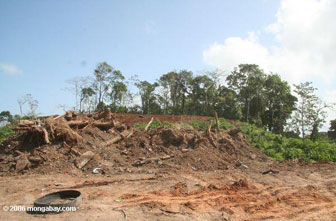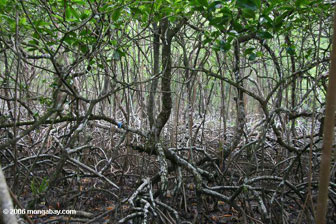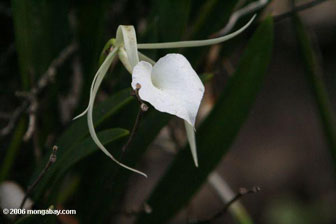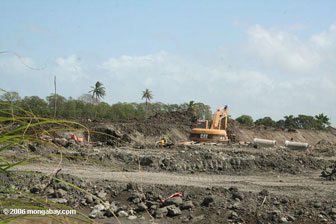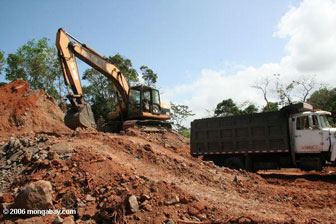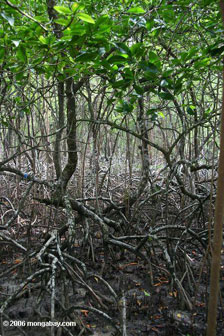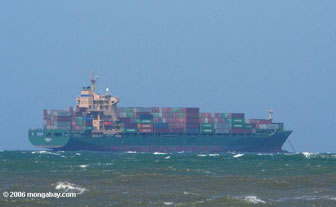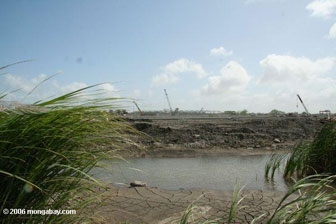Panama Canal port projects threaten mangroves
Panama Canal port projects threaten mangroves
Rhett A. Butler, mongabay.com
March 6, 2007
Port development and land speculation in Panama is turning some of the Caribbean’s most productive mangrove forests into landfill.
The landfill would be used for container storage near the city of Colon, at the mouth of the Panama Canal. But local scientists say the transformation could have unintended environmental consequences.
“Destruction of coastal habitats through port development is currently one of the most pressing environmental issues in Colon,” said Dr. Stanley Heckadon, a distinguished Panamanian anthropologist and historian with the Smithsonian Tropical Research Institute. “But few are actually aware of the issue.”
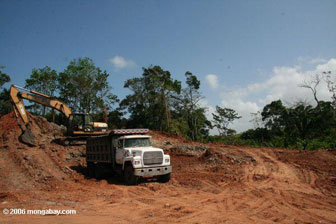 Deforestation and land-filling near Colon. Photo by Rhett A. Butler. Slideshow of Galata |
Panama is home to the largest mangrove forests in Central America. Because the country lies outside the hurricane belt, its Atlantic mangrove forests are particularly rich, serving as a nursery for marine life including species important to local fisheries. They also provide sanctuary for birds. Mangroves and associated sea-grass beds also ensure a range of local ecological services including buffering against storm surge and flooding, water filtration to reduce sedimentation, and anchoring coastal areas from erosion. However, despite their importance, mangroves aren’t much appreciated by the local population.
In Panama, mangroves suffer from an image problem: “No trees in Colon city”
Destruction of the mangrove forests is being fueled by port expansion and the burgeoning population growth caused largely by migration from other parts of the country. Local apathy is also a factor. Heckadon estimates that on the Caribbean side of the Panama Canal the mangrove cover has from 5,000 hectares to 3000 hectares. At the same time in the last three decades the country’s mangrove surface has declined from 5000 suare kilometers to 3,500 square kilometers.
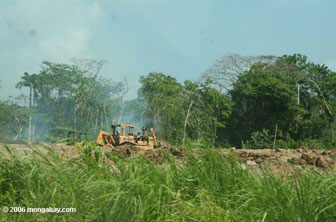 Bulldozer working the mangrove forest outside Colon
|
Some of the areas once off-limits as U.S. military installations are now eagerly eyed by developers and local residents who view mangrove forests as little more than “swamps.” Their status as public lands—owned by nobody—makes them ripe for clearing for container storage, port expansion, or simply land speculation. In speculation, the land is cleared, filled, and then put on the market by developers who can’t afford to do something themselves with the land.
“The community does not assign value to mangroves,” Heckadon said. “Mangroves are hardly mentioned in children’s school books, and few appreciate the services they provide. To most locals, mangroves are a stinking wasteland.”
Heckadon said the local sentiment towards mangroves and the environment in general is reflected by the lack of greenery in the Zona Libre—the free-trade zone of Colon where one can buy anything from cigarettes to luxury purses.
“There are also few trees in the city of Colon,” lamented Heckadon. “This is a statement that business doesn’t care about nature. Developers use every opportunity to clear forests.”
“How many jobs will mangroves create?’ is the question I’m always asked,” he continued. “Developers encourage poor jobless migrants in the cities to pressure politicians, but once a project gets approved they aren’t hired because they aren’t skilled. So while, yes, a lot of wealth is generated by the ports, the railroad and the canal, a barely a fraction remains in the area. Colon has bad roads, bad schools, and bad hospitals. Mangroves don’t have a lobby—in fact they often stand in the way of the local government’s push for infrastructure. Everything is about containers these days.”
Heckadon says the local government hasn’t helped counter popular sentiment toward mangroves.
“Governments set the tone by example,” he said. “In the 1990s it began to clear primary forest for housing developments around Colon that could otherwise be built on already deforested scrub and grassland. Sometimes it would seem that development policy is to get rid of mangroves. We’re trying to change perceptions. Through the environmental education program at Galeta Point Marine Laboratory, we’re bringing kids to see mangroves so they understand them and appreciate them. We are trying to provide an important service to the community, especially when you look at the style of development that is going in surrounding areas.”
Further protected areas can be a tough sell in Panama
In a country where more than half the land is effectively off-limits to development as indigenous comarcas (or reservations) and protected areas, complaints about environmental degradation can seem petty and unreasonable to developers.
“More than half our country is protected. How much more do these scientists want?” asked Luis, a proprietor in a neighboring province. “Enough is enough.”
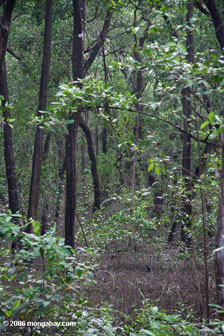
|
Still, Heckadon said, it is possible to win support from the business community. He noted that the Manzanillo port has worked with STRI to help build marine exhibits and sponsor annual field trips by thousands of chidren from poor village in Panama.
“We get a good response from visitors,” he said. “Children are very enthusiastic about nature after the visit and, surprisingly, so are their parents. I’ve had parents come up to me wide-eyed after a tour saying, Had known about this before I would have visited and brought you a chicken.’ We’re not Sea World, but we are making a difference with our mangrove walkways and outreach program.”
But he added, “We’ve tried inviting the new Chinese-run ports but haven’t gotten a response.”
Heckadon said that while he is still trying to win business support from Colon, STRI has actually made more inroads with the disaffected local farmers and fishermen who were once the greatest threat to the protected area.
“Squaters and artesanal fishermen were once adversaries, but now they are our friends,” he said.
“The first group Galeta had to deal with were squatters who had lost their homes in a fire in Colon city. They were moved to old barracks left by US Navy at the entrance to the park and they were hunting iguanas, poaching crabs, and collecting parakeets for sale, so we spend lots of energy inviting them to get to know the lab, its scientific and educational projects, to talk. Today the community of Coco Solo is our friend. Currently we’re working with the small hook and line fishermen from the port city of Colon. In Central America, there is huge demand from Chinese for shark fin soup—thousands of sharks are killed. This is an issue we need to address at the local level, but it can be difficult given what the locals see as a double standard in development.”
Heckadon is referring to the parallel world in which small-scale farmers and fishermen are told not to hunt in or encroach on protected areas, while big developers are given apparent free rein over large swaths of forest.
“We tell little guys not to fish or hunt in a protected area while 100 yards away big guys are destroying an entire ecosystem,” Heckadon said. “It’s no wonder small farmers see a double standard. The powerful seldom, if ever, go to jail, and seldom have problems with environmental impact studies. ”
A big container project
Recently, Heckadon learned that Evergreen Marine Corp, a Taiwan-based shipping firm, had gotten the go-ahead from Panama’s environmental authorities, to clear 50 hectares of prime mangrove forest at the entrance to Galeta Island Protected Landscape. The environmental impact study for this port expansion project was largely kept from the public eye.”
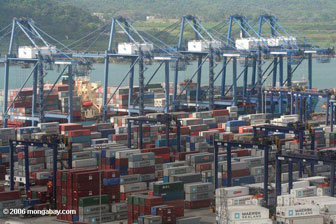 Containers stacked along the Panama canal
Draining, clearing, and land-filling for the Evergreen port project. Photos by Rhett A. Butler |
Not long ago, as he drove toward the Galeta park entrance through the mangrove forest, a team of surveyors were taking measurements for Evergreen. Heckadon stopped to ask them some questions.
“Are you surveying for Evergreen?”
“Yes. Everything to the right is going be cut,” the contractor said as he waved to the tract of pristine mangrove forest.
“When?”
“Evergreen wants this done quickly.”
Heckadon says that it looks like Evergreen will eventually clear all the forest leading to the boundary of Galeta. We drive on and are soon waved down by a member of the environmental police.
“Did you hear about Evergreen?” the ranger asked.
“Yes,” said Heckadon.
“What can we do?” asked the ranger.
Heckadon sighed and said “I don’t know. For now.”
Later, as we stand by the touch tanks which help visiting children get a better understanding of local marine life, Heckadon says he does know what needs to be done.
“We need to continue and expand our education program so people know about this. Mangroves are important. So are sea grass beds and coral reefs. These ecosystems sustain fisherman and help prevent flooding from storm surge and heavy rains. Locals just don’t know this. Yet.”
A few minutes later, Heckadon learns there may be an additional option. A visiting McGill University who has been perusing the Evergreen web site finds a clause stating its environmental policy which pledges the firm to “meet the requirements of applicable International, United States federal, state, and domestic environmental laws and regulations in all operational activities.”
Heckadon smiled and said. “This may be our chance.”
